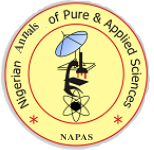Synthesis, Characterization and Antimicrobial Evaluation of Mn(II) and Zn(II) Schiff base Complexes with p-hydroxypropiophenone moiety
DOI:
Keywords:
Schiff base, 1H NMR, 13C NMR, FTIR, UV-visible, metal complexes, antimicrobialAbstract
The Schiff base was synthesized by condensing 4-aminopyridine with 4-hydroxypropiophenone. The synthesized ligand was characterized by proton and carbon-13 NMR spectroscopy, electronic spectroscopy and FTIR.The result of the FTIR showed the presence of a band at 1643.41cm-1 assigned to the azomethine bond, also the result of the 1HNMR and 13CNMR gave credence to the successful synthesis of the Schiff base. The Mn(II) and Zn(II) complexes were characterized by UV-visible analysis, FTIR, molar conductivity measurement and magnetic susceptibility test. The results of the FTIR suggest that the metal complexes possess coordinated water molecules and the shift in the wavenumber of the azomethine linkage in the spectra of the complexes shows that the nitrogen of the imine bond participated in the coordination to the metal centre. The magnetic susceptibility measurement shows that the metal complexes possess octahedral geometry. The molar conductivity test shows that the complexes are nonelectrolytic in nature and the metal to ligand ratio is 1:2. The synthesized ligand and the metal complexes were evaluated for biological activities against some organisms. The Zn(II) complex showed significant activity against the test organisms.



 Contact Us
Contact Us Editorial Team
Editorial Team Join As A Reviewer
Join As A Reviewer  Request For Print Copy
Request For Print Copy


 Cprint Publishers
Cprint Publishers